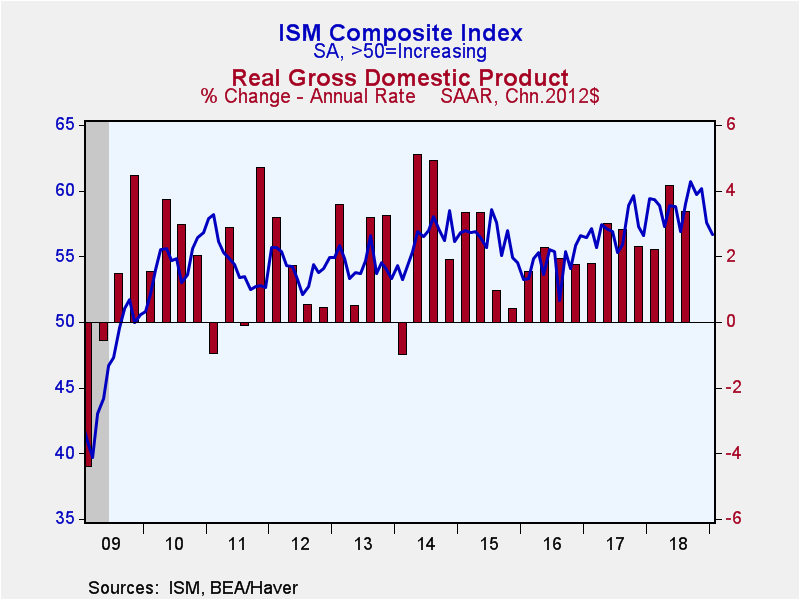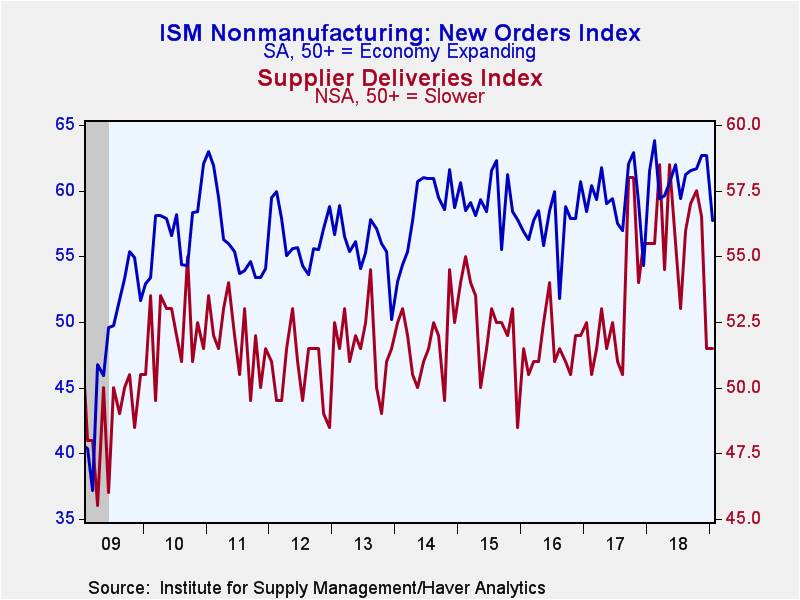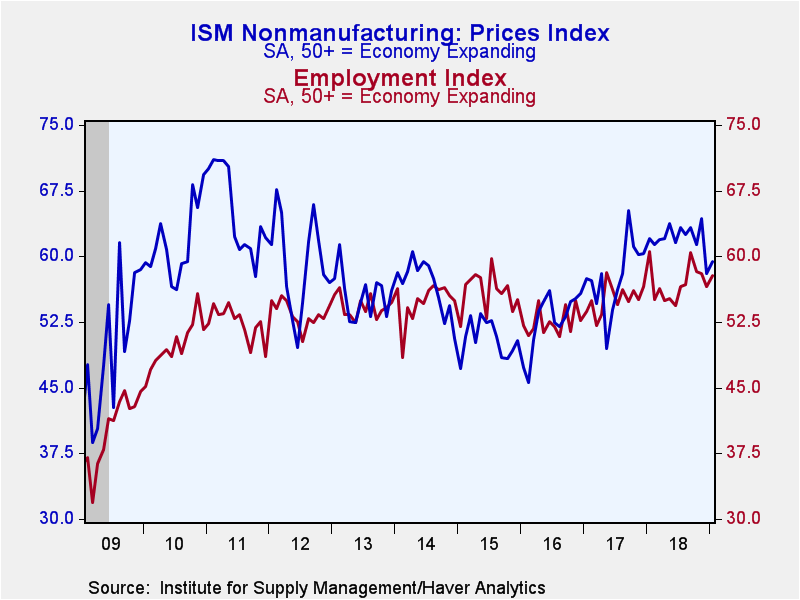 Global| Feb 05 2019
Global| Feb 05 2019U.S. ISM Nonmanufacturing Index Declines Again
by:Tom Moeller
|in:Economy in Brief
Summary
The Composite Index of Nonmanufacturing Sector Activity from the Institute for Supply Management (ISM) fell to 56.7 during January from December's 58.0, revised from 57.6. The index has been declining since a high of 60.8 in [...]
The Composite Index of Nonmanufacturing Sector Activity from the Institute for Supply Management (ISM) fell to 56.7 during January from December's 58.0, revised from 57.6. The index has been declining since a high of 60.8 in September. Expectations had been for 57.0 in the Action Economics Forecast Survey. Earlier figures were revised due to new seasonal factors. A reading above 50 indicates expansion and the figures date back to 1998.
Haver Analytics constructs a Composite Index using the ISM factory sector series released on Friday and the ISM nonmanufacturing index. The index fell sharply, also to 56.7, down from a September high of 60.7. During the last ten years, there has been a 56% correlation between the index level and the q/q change in real GDP.
A decline in the new orders index to 57.7, its lowest level since August 2017, led the overall nonmanufacturing index lower. The business activity reading also fell sharply to 59.7, the lowest level in six months, down from a November high of 64.3. The supplier deliveries index held steady m/m at a sharply reduced 51.5, the lowest level since August of 2017.
The employment component moved up slightly m/m to 57.8, but remained well below the September high of 60.4. Twenty-two percent of respondents reported a rise in payrolls, down from 26% in December. A slightly lessened 13% reported a decline.
The prices paid index rose slightly to 59.4 but was below the November high of 64.3. An increased 25% of respondents reported higher prices while a steady eight percent reported a decline.
Amongst the other series in the nonmanufacturing survey, the export order series collapsed to the lowest level in two years. The order backlog series rose slightly m/m but remained well below the high last May. The inventory change index also fell sharplys and showed liquidation of inventories for the first time in twelve months.
The ISM figures are available in Haver's USECON database, with additional detail in the SURVEYS database. The expectations figure from Action Economics is in the AS1REPNA database.
How Much Could Negative Rates Have Helped the Recovery? from the Federal Reserve Bank of San Francisco is available here.
| ISM Nonmanufacturing Survey (SA) | Jan | Dec | Nov | Jan'18 | 2018 | 2017 | 2016 |
|---|---|---|---|---|---|---|---|
| Composite Diffusion Index | 56.7 | 58.0 | 60.4 | 59.4 | 58.9 | 57.0 | 54.9 |
| Business Activity | 59.7 | 61.2 | 64.3 | 60.1 | 61.5 | 60.2 | 58.0 |
| New Orders | 57.7 | 62.7 | 62.7 | 61.5 | 61.3 | 59.3 | 57.6 |
| Employment | 57.8 | 56.6 | 58.0 | 60.5 | 56.9 | 55.1 | 52.5 |
| Supplier Deliveries (NSA) | 51.5 | 51.5 | 56.5 | 55.5 | 55.8 | 53.2 | 51.5 |
| Prices Index | 59.4 | 58.0 | 64.3 | 62.0 | 62.1 | 57.6 | 52.6 |
Tom Moeller
AuthorMore in Author Profile »Prior to joining Haver Analytics in 2000, Mr. Moeller worked as the Economist at Chancellor Capital Management from 1985 to 1999. There, he developed comprehensive economic forecasts and interpreted economic data for equity and fixed income portfolio managers. Also at Chancellor, Mr. Moeller worked as an equity analyst and was responsible for researching and rating companies in the economically sensitive automobile and housing industries for investment in Chancellor’s equity portfolio. Prior to joining Chancellor, Mr. Moeller was an Economist at Citibank from 1979 to 1984. He also analyzed pricing behavior in the metals industry for the Council on Wage and Price Stability in Washington, D.C. In 1999, Mr. Moeller received the award for most accurate forecast from the Forecasters' Club of New York. From 1990 to 1992 he was President of the New York Association for Business Economists. Mr. Moeller earned an M.B.A. in Finance from Fordham University, where he graduated in 1987. He holds a Bachelor of Arts in Economics from George Washington University.










